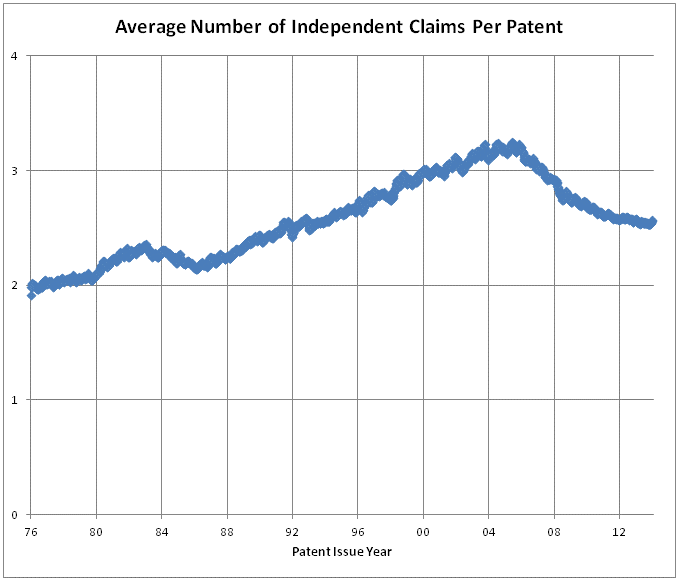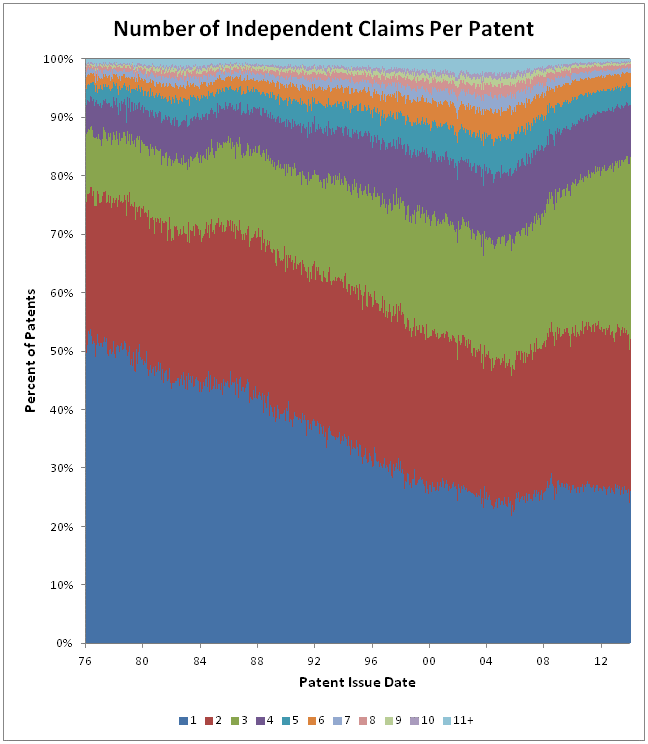By Dennis Crouch


These charts are based upon an analysis of all 4.7 million patents issued between January 1976 and January 2014. I basically tallied the number of independent claims in each patent and grouped those according to the patent issue date. Throughout this time, patents have only issued on Tuesdays each week.
The first chart shows the average number of independent patent claims issued each week. Readers will notice a fairly steady rise in claim-count until around 2004 and a significant drop following that. The second chart uses this same data but adds a finer analysis. The second chart shows the proportion of patents having a given number of independent claims. This chart shows the steady rise in claim-count from the 1970s through 2004 is largely explained by a shift away from patents having only one single claim and toward patents with more than three claims. Since 2004, the tide has changed. There are now many fewer patents with more than three claims and a substantial increase in the number of patents with exactly three independent claims.
If one were to replace the current 103 with an “objective” test, what would it be?
1. The test for invention used by the Europeans?
2. Something like Eibel Process: difference in kind, not degree?
3. Some version of TSM that accommodates obvious to try?
The reason I ask is that the current test really isn’t helpful. In the end, one gets two “experts” simple declaring their own views and sprinkling their opinion with the magic words of the 103 incantation. But what are they really trying to say? That a known problem was solved? That the new invention is sufficiently different in functionality from what went before to justify a patent?
Should we consider the difference between the time the need for an invention arose and the solution, perhaps in addition to the fact that it was solved?
OT, but it’s always funny when the New York Times turns to the wealthy for examples of the “hardships” caused (directly or indirectly) by the Great Recession. Even funnier, of course, when it’s a lawyer. Super duper funny when it’s presented as an explanation as to “why lawschool applications are down” and “there’s widespread malaise in big law firms.”
link to lawyersgunsmoneyblog.com
Get into a different line of work Malcolm – the self-h@te you carry is stultifying.
the self-h@te you carry is stultifying.
LOL! I don’t h@te myself, TB. I don’t even h@te weirdo nimrods like you.
Ask your nurse to open a window if you’re feeling “stultified.”
That you deny that you h@te is no surprise given that you have no feelings of shame or intellectual honesty.
Your perceptions are warped. You need help.
[…] reply to a prior post, one comment asked about the whether US patents tend to have claims directed to both an apparatus […]
It seems to me that when the popular press compares numbers of patents companies have, it is not so relevant because of the varying number of claims per patent. Or, is such a count close enough for the popular press.
The count is most likely close enough because even though the number of claims may vary (and the number of types may vary), a patent is meant to cover only one ‘inventive concept’ (also known as unity of invention).
If there are separate inventive concepts, a restriction requirement is often invoked by the Office and the separate inventions may be pursued by the applicant with filing of divisional applications.
I agree that it is not wrong to talk about patent-count and there are many ways that we look at patents as a whole. However, there is always more complexity and there are many legal doctrines that focus on a claim-by-claim basis.
My interest in the subject is in modern drafting for use all over the world, and so in the number of independent claims per”category” that is to say, apparatus, process, product, use.
As we all know, patents issued by the EPO routinely have more than three independent claims, but only one in each category.
I suppose that the very opposite is true at the USPTO’s issuances till now: a plurality of independent claims but, invariably, all in the same single “category”.
Given that the USPTO is adopting the EPO’s subject matter classification key, and problem and solution analysis whether the invention was an obvious one, will PPH politics and ever greater globalisation of patent drafting foster, very very slowly, a trend in the USPTO towards patents issuing with independent claims in more than one category (but only one per category)?
MaxDrei: “I suppose that the very opposite is true at the USPTO’s issuances till now: a plurality of independent claims but, invariably, all in the same single ‘category’.”
Why would you suppose that? (not snark)
For the reason given below by Ned. Simples, no?
Not really, as joinder is often taken in prosecution when the type of restriction Ned notes is the only basis.
Max, because our restriction practice typically restricts between apparatus and method claims, I would suspect that the data primarily represents patents having only one category.
By the way, if given a restriction between apparatus and method, which do you choose to prosecute normally and why?
Ned, I would restrict to the one which better reflects the inventive contribution to the art. From what I see, American drafters are fond of dependent method claims that recite apparatus features, and vice versa. To me, this seems artificial.
Suppose the inventive concept is the feature combinatiuon X+Y+Z and that the concept can be claimed as an apparatus (means for X-ing, means for Y-ing etc) or a process (the steps of X-ing, Y-ing etc). In issued EPC patents you will see routinely see such claims in peaceful co-existence. Which to select in the USPTO? The one that gives my client the most market power, I guess.
Can you clarify?
When you say “dependent method claims that recite apparatus features” you do not mean the obviously problematic mixed statutory class claims, right?
You ostensibly mean correctly written single class claims that happen to portray the essence of apparatus in the correct method class (or vice versa), right?
(I ask to forestall a post by 6 yammering on about how such mixed class claims would fail in the first instance, rather than to throw any snark at you)
I’m going to look into this.
No rest for the wicked…
😉
“Given that the USPTO is adopting the EPO’s… problem and solution analysis whether the invention was an obvious one”
MaxDrei, this is clearly not correct – as my recent post (and Hal Wegner’s upcoming patent event) clearly shows the opposite to be the case: that in the US, the KSR decision makes a strict problem and solution approach to writing applications decidedly inappropriate due to the danger of an over-aggressive obviousness analysis.
And yet again MaxDrei disappears after his two minutes atop his soapbox…
No conversation for you (said in the best Soupn@zi tones)
Comments are closed.